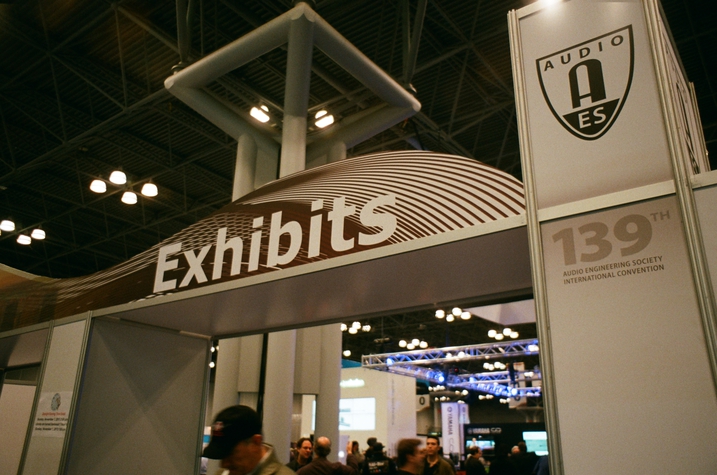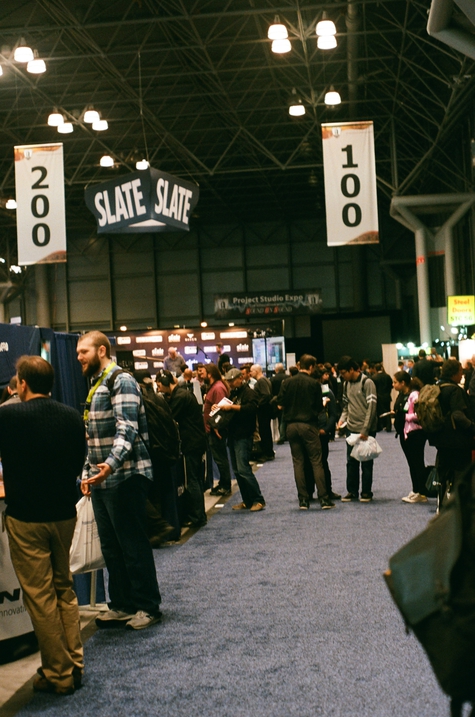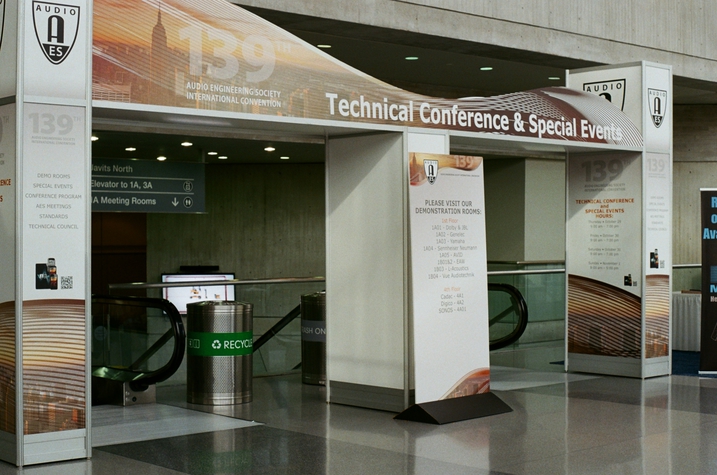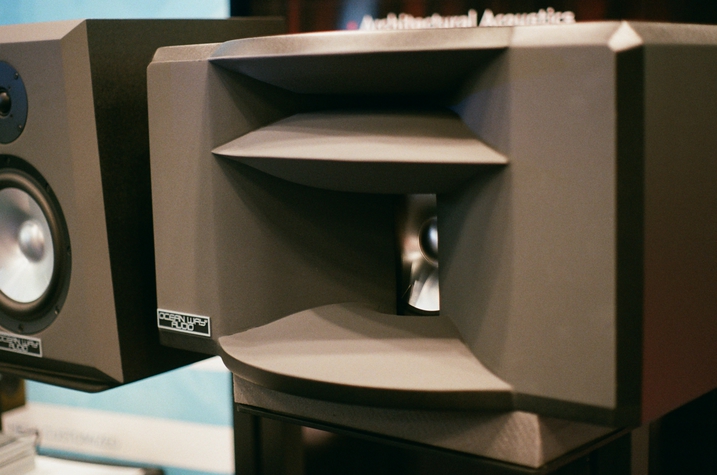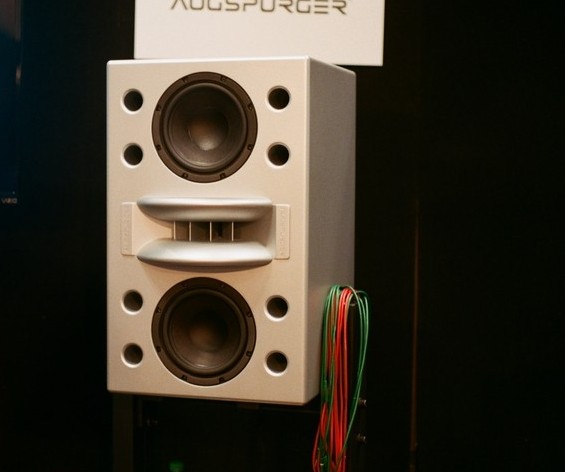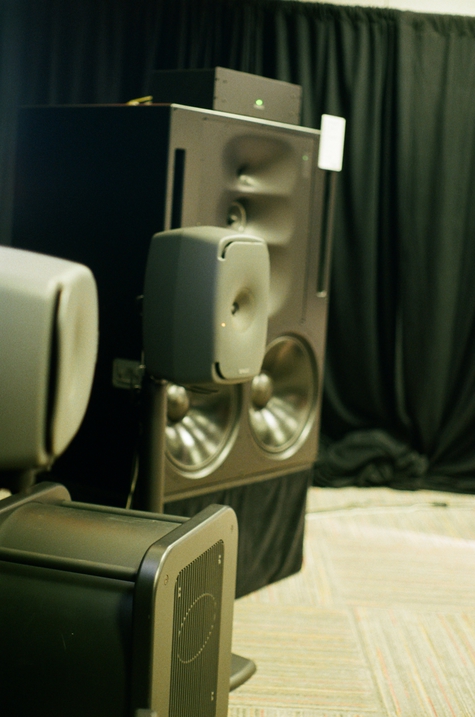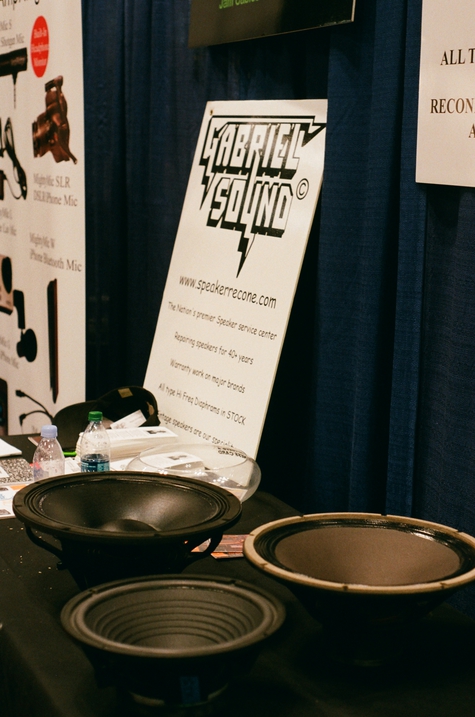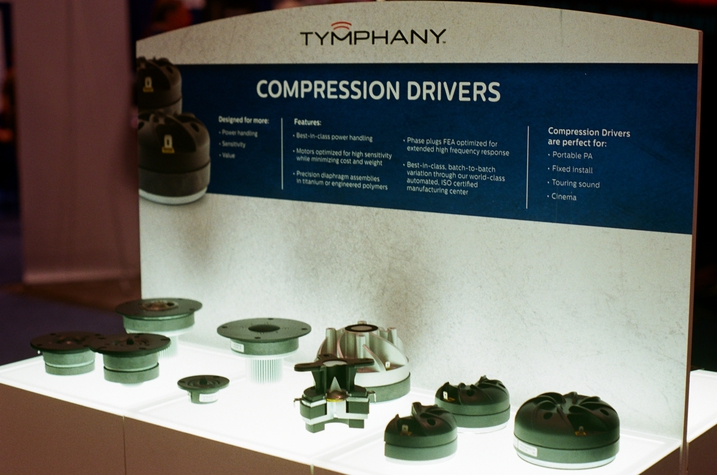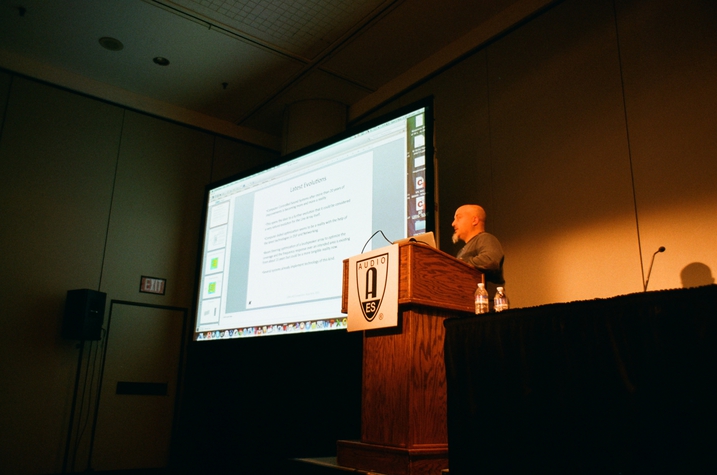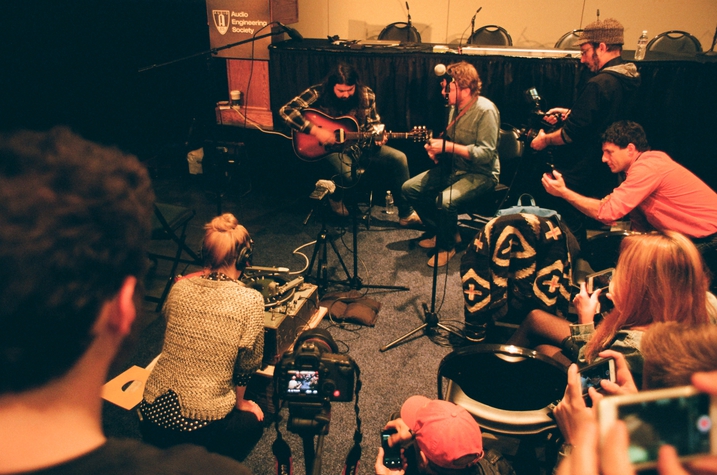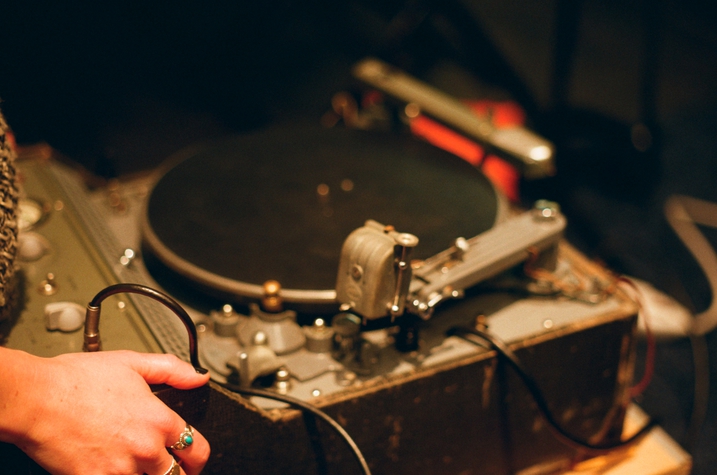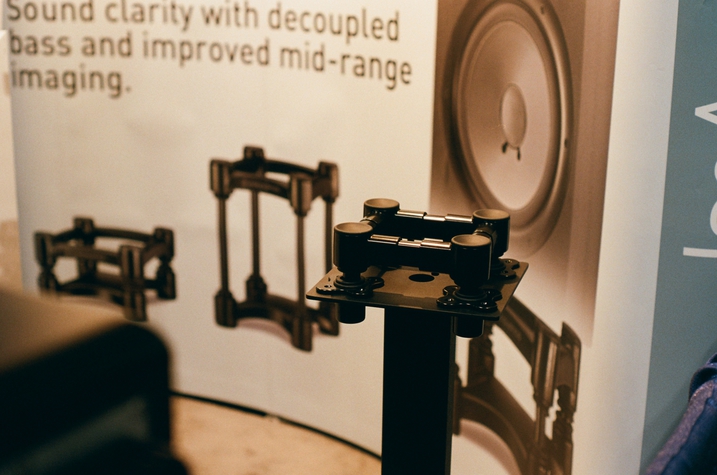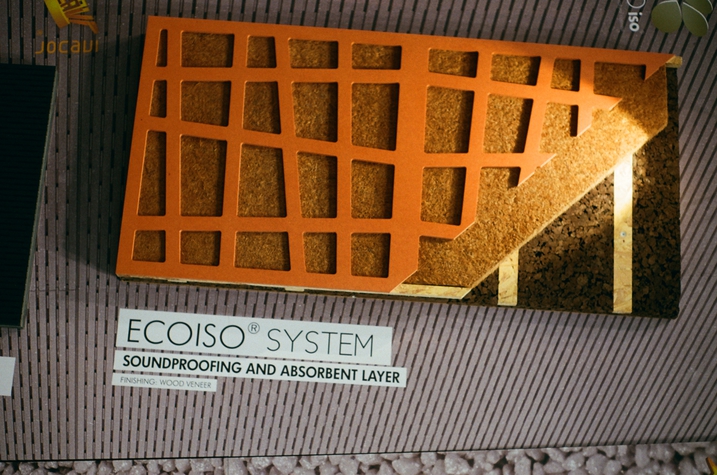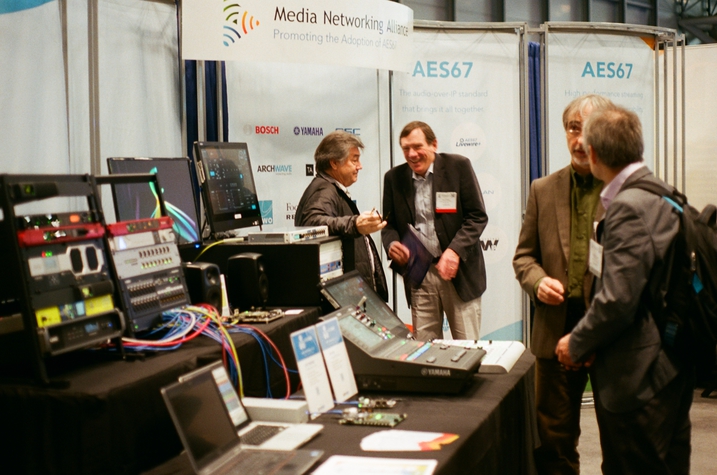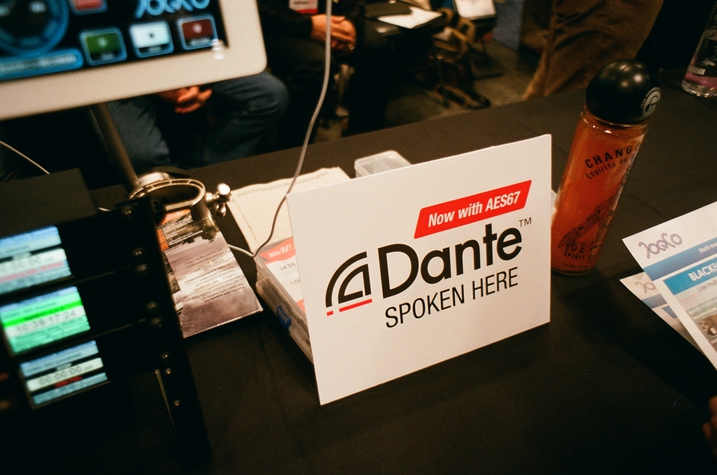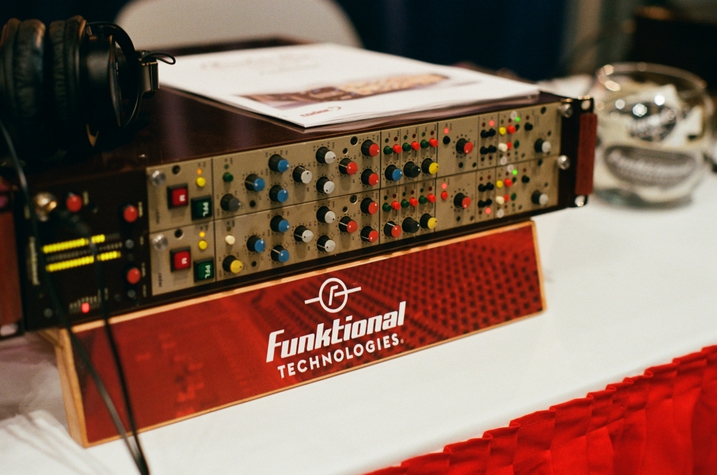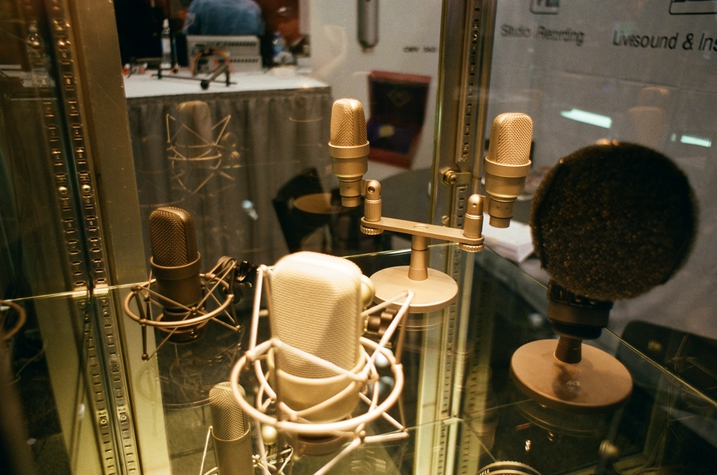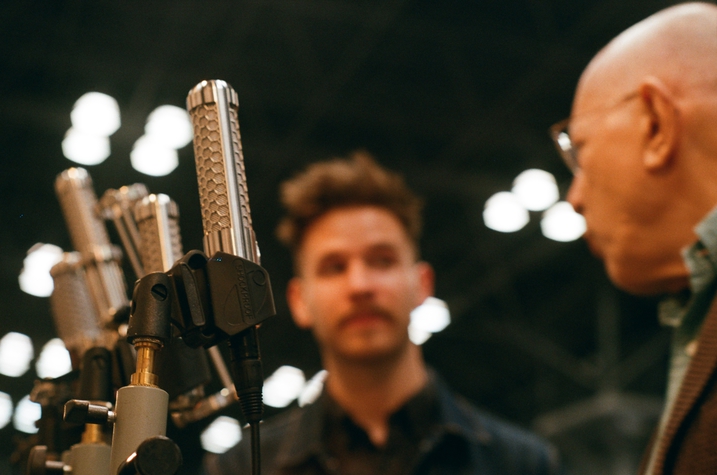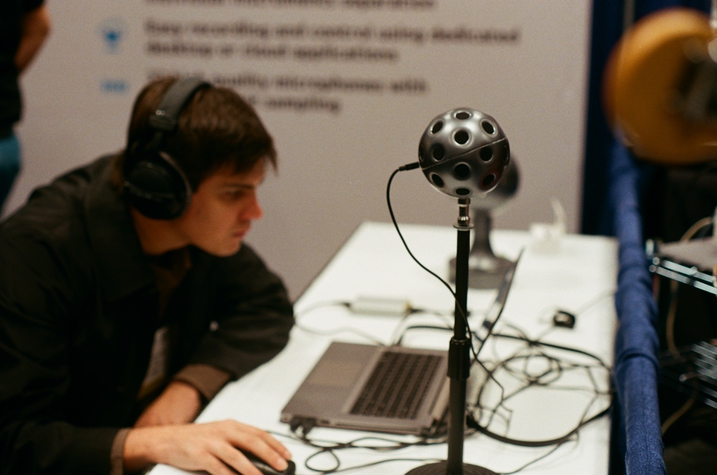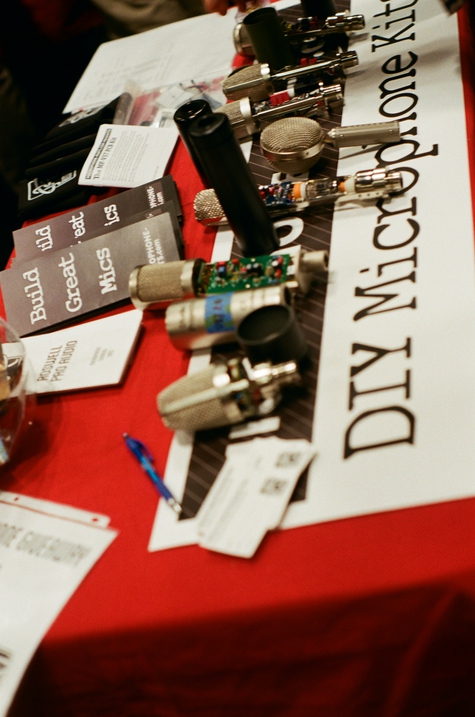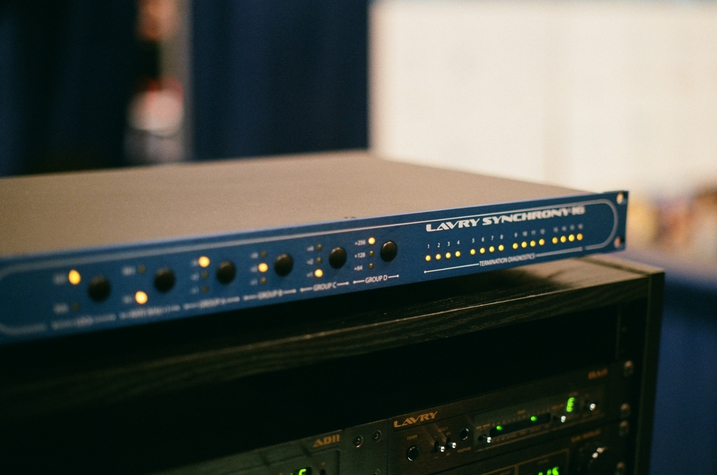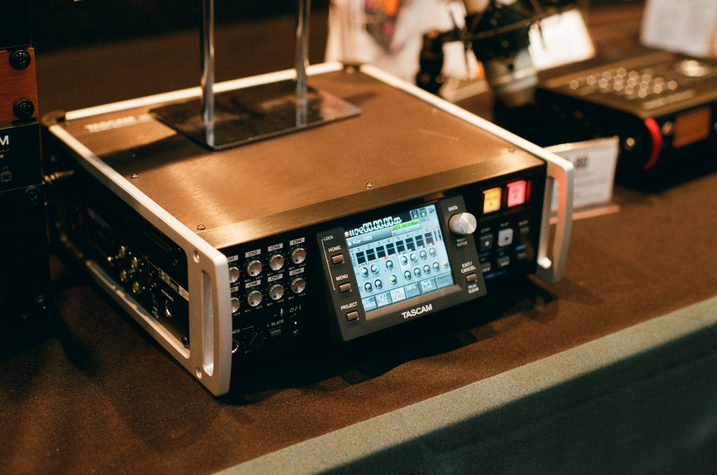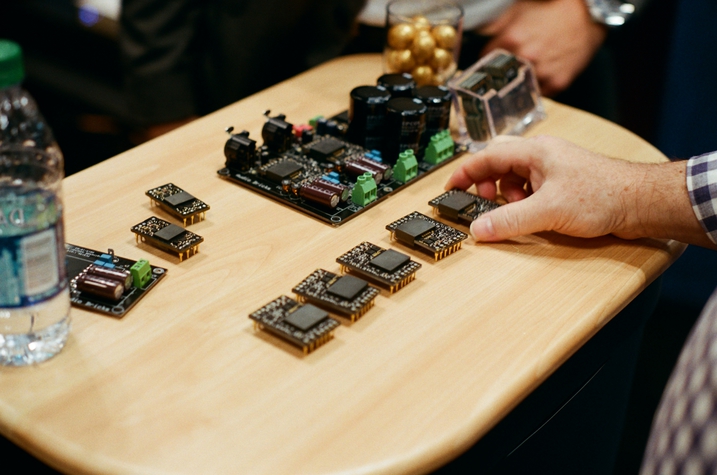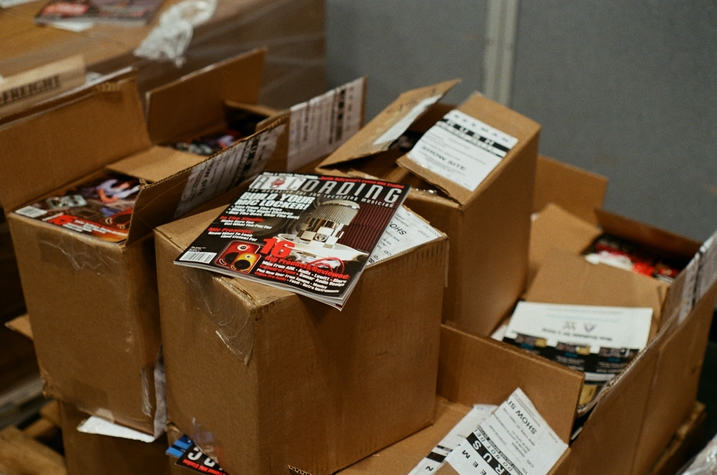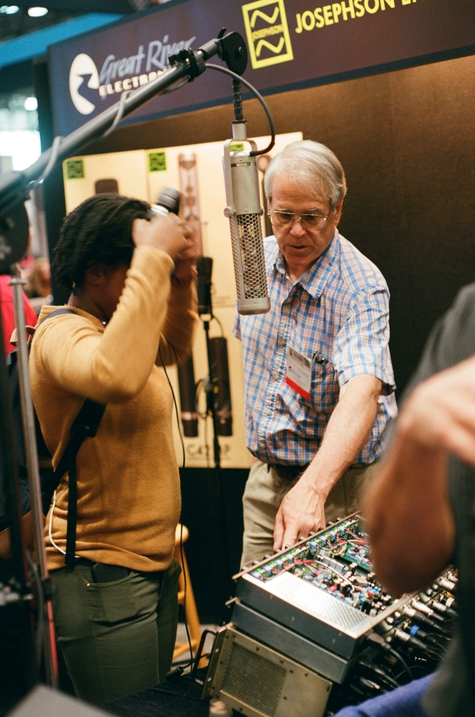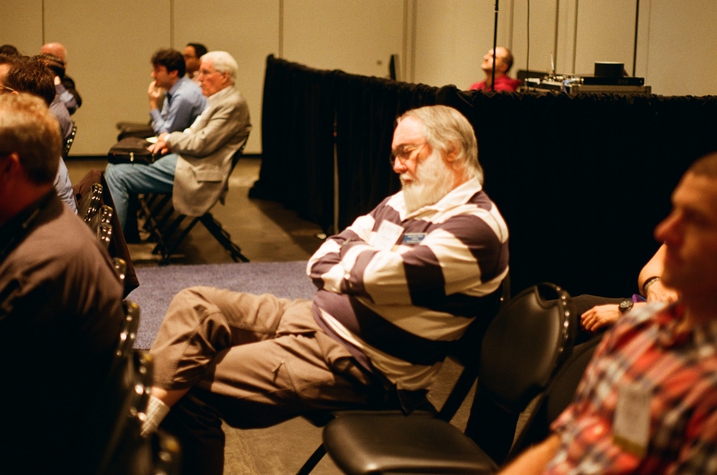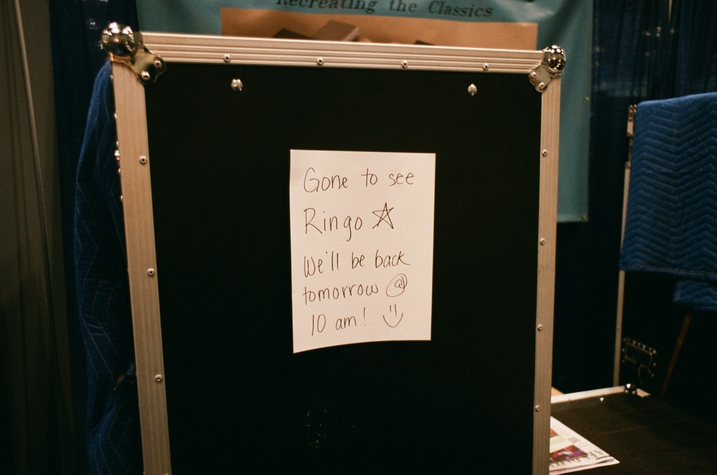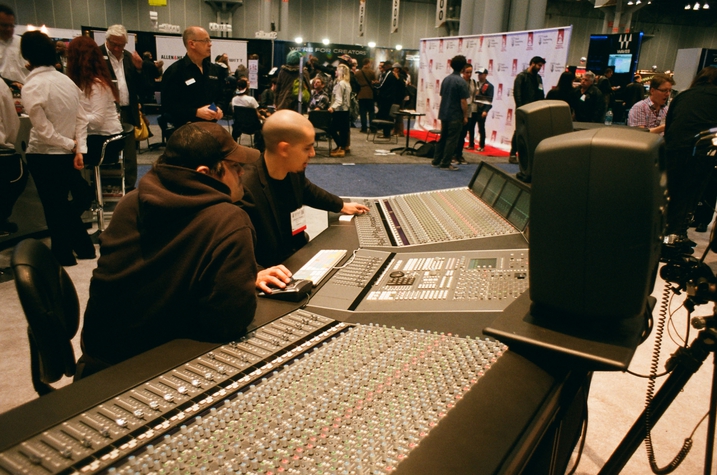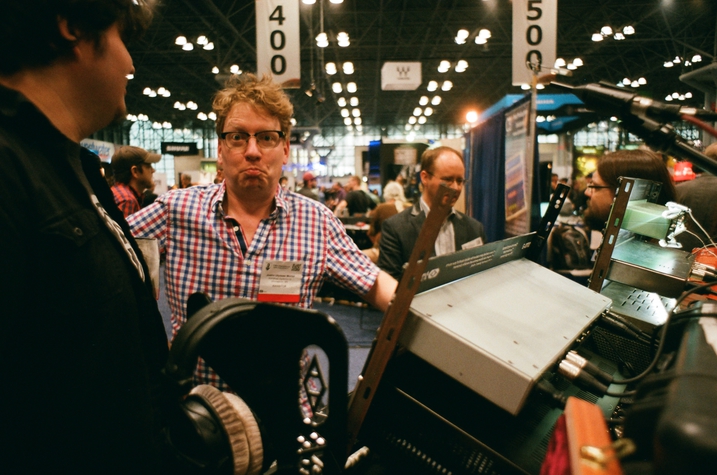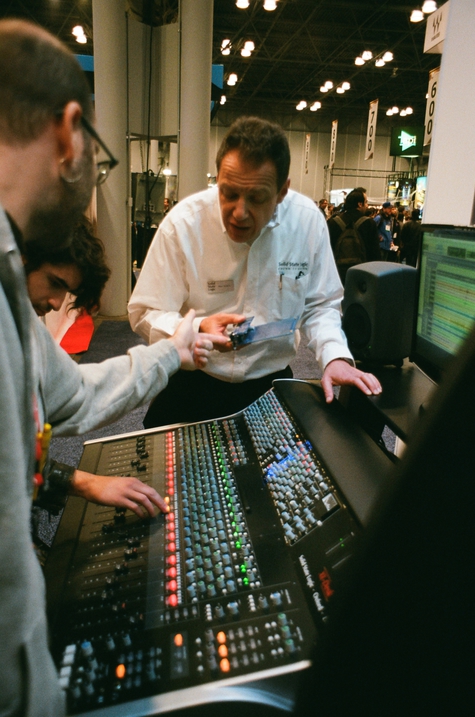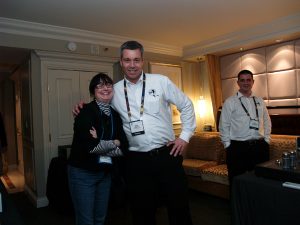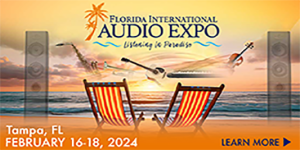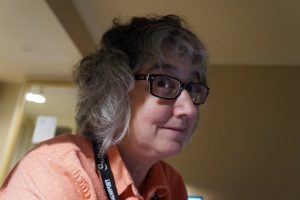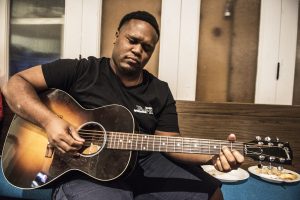As always, I enjoy writing about a professional audio conference for the high end community. The AES show is really two things, it's a bunch of people upstairs selling hardware mostly to professional production people, and it's a different bunch of people downstairs talking about science and technology. What makes the AES different from other audio events is the interaction between these two groups: because of the papers going on downstairs, you can find the engineers who actually designed the products upstairs. This year's show in New York was no exception and had a lot of interesting material.
Monitor Speakers
Ocean Way and Augspurger were both showing off smaller versions of traditional large-scale studio monitors. It used to be, you'd go into a large studio and see horn-loaded soffit-mounted monitors, but as rooms are getting smaller and budgets tighter these are becoming rare. Even so, people still want the sound of those designs: very tight radiation pattern in the vertical plane so room problems at high frequencies are reduced, very wide sweet spot, and a very forward and analytic sound. Both Augspurger and Ocean Way have traditionally delivered this sort of sound. Augspurger was showing the Duo 8 Minimain system, active loudspeakers with dsp processing and traditional sectoral horns, while Ocean Way was showing their HR4, a powered system with a similarly wide but undivided horn. Longterm readers will recall I am not a huge fan of horns, but these systems provide the forwardness that many people like from the horn without providing the honk and blur that people don't like. Both of these speakers are part of the new generation of high technology horns and anyone interested in horn speakers for any reason, for studio monitors, for home listening, or for small high-end sound reinforcement, would do well to check these systems out.
PMC was demonstrating a line of small minimonitors based around transmission line cabinets. Their 22.5, 22.6, and 22.8 speakers vary in size but have similar sound characteristics. Clean top end without being spitty, but beyond that it was hard to tell in the show environment. I'd be curious to see what the bass accuracy really is like in a good room.
Barefoot was selling their MicroMain 45. This is another small monitor, a scaled down version of one of their larger high grade studio monitors, but small enough that an engineer can take them along with him from one studio to the next and have an environment he's used to that can travel with him.
Genelec was showing their 8351 coaxial monitors but again the demo material made it hard to tell much about the speakers. I keep trying to hear these speakers under good conditions but never really get a chance.
Sonos was showing some small wireless speakers intended for home use, boxes with integral batteries and class D amplifiers. Their demonstration was clipping on peaks.
The paper Vibrational Analysis of Vintage Planar Loudspeakers by Michael Heilemann and others from the University of Rochester was a bit surprising. Given the title, I walked into it expecting an analysis of conventional membrane planar speakers (magnetoplanars and electrostats), but apparently in the 1970s Yamaha and Poly-Planar sold distributed mode loudspeakers, long before anyone actually had come up with that name, and these folks did a mechanical analysis of these speakers. Interesting from the standpoint of speaker history, especially as distributed mode technology becomes more popular for hidden speaker designs in consumer products. e-brief 229.
Loudspeaker drivers are supposed to produce sound, but the cabinets are not supposed to be radiating sound. Unfortunately since they are made of real materials, they do radiate and can contribute substantially to distortion. In Predicting the Acoustic Power Radiation From Loudspeaker Cabinets: a Numerically Efficient Approach, M. Cobianchi and M. Rousseau from B&W built a finite element model capble of predicting cabinet radiation and spent some time testing it against real speakers. Preprint 9367.
Speaker Drivers
There were also a large number of companies selling bare speaker drivers for speaker manufacturers or hobby speaker builders. These included Tymphany, a large well-established speaker vendor who has, among other things, the patent on the ring radiator. It also included smaller companies like Gabriel Sound (speakerrecone.com), a company that specializes in rebuilding and repairing speaker drivers and cabinets to original specifications.
Niels Iversen and two other students from the Technical University of Denmark gave a talk called "Low Impedance Voice Coils for Improved Loudspeaker Efficiency." Although technically correct, they should call them "low resistance voice coils" since the point of the paper is on reducing voice coil resistance through the use of square wire which permits tighter packing of the voice coil. (This actually becomes more a benefit the higher the coil impedance is, because there are that many more winds to be packed better). Nothing innovative, but still worthwhile. Preprint 9389).
A lot of manufacturers have been using exotic materials like evaporated diamond films, chromium nitride, or plain chrome onto aluminum and titanium tweeter domes. Can a thin coating actually make substantial structural changes to a comparatively thick dome structure. In Effectiveness of Exotic Vapour-Deposited Coatings on Improving the Performance of Hard Dome Tweeters, Peter John Chapman from B&O tests a variety of coatings on a variety of substrates and comes to the conclusion that any improvements are limited at best. Yes, he does distortion measurements, sweeps, and listening tests. Preprint 9390.
In Time-Frequency Analysis of Loudspeaker Sound Power Impulse Response, Pascal Brunet, Allan Devantier, and Adrian Celestinos from Samsung Research America detail the various benefits of looking at spectrum vs. time at different angles when searching for speaker resonances, and detail some examples of resonances that can be equalized out in crossover design and some that cannot, along with tips on identifying which is which. Preprint 9354.
Beyond Surround
Neumann has purchased Klein and Hummel and is selling some very nice little monitors based around their technology. However, the only demo they had at the show was a Dolby Atmos demonstration with many, many channels and no real actual stereo imaging or depth. You could locate the speakers that each one of the sounds was coming out of. This is no condemnation of these excellent speakers, but it is definite condemnation of the source material (or possibly the use of Atmos for recorded music in this fashion at all, when it is in fact intended for film soundtrack work). I'd love to have heard a better demo.
David Bowles from Swineshead Productions spoke on A microphone array for recording music in surround-sound with height channels. He describes a typical 5.1 playback system with four height speakers added, making it effectively a 9.1 system. He then describes several different ways of making recordings for this playback, using a single microphone array, and describes subjective effects and perceived imaging of each. Very interesting for anyone curious about multichannel sound. Preprint 9430.
Similar in intent even if not application was Polar Pattern Comparisons for the Left, Center and Right Channels in a 3-D Microphone Array by Margaret Luthar and Elaine Maltezos. They tried out a variety of different microphone configurations for a 9.1 system, seemingly at random, and gave subjective evaluations of each of them. They agreed strongly that the added height channels gave a greater sense of envelopment and improved sense of space. e-brief 206.
Headphones
There was a lot of headphone stuff at the show, but the one thing that really stood out for me was that Shure is now selling an electrostatic earphone system. Tiny earbuds, with tiny elecrostatic transducers, and a beltpack amplifier to drive them. It was hard to tell how they sounded at the show but what I heard was pretty good.
Direct Sound was also showing off their line of very high isolation headphones. With their demo it was hard to tell how good the audio quality of the phones were, but they sure did a great job of blocking out noise from the show. I could have sat there all day with them on my head and enjoyed the quiet.
In An Audible Measurement System Covers both Audible Frequency and beyond 20 kHz, Naotaka Tsunoda and two others from Sony construct and artificial ear based on a subject's ear and use it to measure response of headphones up to ultrasonic frequencies. Test-retest reliability is good, but it is very difficult to generalize from an arbitrary ear configuration to that of any other listener (which is of course much of the difficulty in making and interpreting headphone measurements). This is an interesting study but I am not sure it can be generalized in any useful way to actual listeners Preprint 9375.
Christopher Struck and Steve Temme talk about some of the many difficulties in making headphones flat and even defining what "flat" means in the paper Headphone Response: Target Equalization Trade-offs and Limitations. A good discussion on what equalization can and cannot do. Preprint 9374.
Sound Reinforcement Loudspeakers
L'Acoustics is the company that popularized line arrays, and they have had a line of large high-powered array speakers for large halls for many years. But, they are now introducing some smaller PA speakers using coaxial drivers called the X-Series. Their X8, for instance, is a compression driver with an 8" woofer in a small, light cabinet, very constant directivity because of the coaxial configuration. I wasn't able to get a good audition of it, but the basic driver arrangement is a fine one for high grade sound reinforcement of acoustic music.
Meyer, another long-time player in that market, was showing off the Leo family of line array systems varying from moderate-sized systems for small venues to stadium-sized arrays.
Yamaha now owns Nexo, a compay that has been making smaller line array systems for many years, and they showed the Geo M260 and Geo S12 small and medium line array systems which look like good choices for a small festival venue.
EAW was selling a very large line array system, the Anya, with dsp processing behind each cabinet and therefore the ability to control the speaker pattern on the fly with remote computer control. This is a big deal for touring acts who are often forced to fly their speaker system before being able to actually design the system, and this allows acoustic design after the speakers have been hung.
Paul Beckmann from DSP Concepts gave a tutorial called Practical Loudspeaker Processing for the Practicing Engineer. In some ways it was very much a sales talk for his modular dsp software, but mind you that was not a bad thing since his software allows you to design a dsp system in Matlab with a Simulink-like interface, then generate code and drop it into a dsp module which can be then used in an installed product. There was less discussion than I would have liked about the physics and the compromises of filter designs, but the software/hardware package described was ingenious and allowed very rapid prototyping.
In A novel approach to Large-Scale Sound Reinforcement Systems, Mario Di Cola from Audio Labs and Alessandro Tatini from K-Array talked about using a dipolar speaker array for sound reinforcement. The main advantage of the dipole is a very good null on the side, and if things can be arranged so that the performers are in the null it can greatly reduce leakage and improve gain before feedback. Preprint 9479.
Don Keele gave a presentation written by Xuelei Feng, Yong Sheng, himself, and Jie Xia, on Directivity-Customizable Loudspeaker Arrays using Constant-Beamwith Transducer (CBT) Overlapped Shading. This presented what was basically a new filter arrangement to take a single signal and distribute it across a line array, using Legendre shading, to give a directional pattern with few side lobes and comparatively flat response across the pattern. One of the big advantages of this method is that a few small weights can control the shape of the polar pattern which makes adjusting the array very easy both computationally and for users. Preprint 9478.
Phono Stuff
Down in the archiving sessions, Brad McCoy and Nadja Walleskovits from the LoC and Vienna Phonogramarkiv respectively, gave a presentation on preserving and playing back Edison Cylinders. Starting with an overview of the various technologies from instantaneous wax recordings through molded Blue Amberol recordings, Brad then described the Archaeophone playback system which uses a Stanton stylus on a modern cylinder playback bed. The talk was fascinating in part because it was accompanied by archive audio material that actually sounded surprisingly good.
Later on in that same track, Alex Steyermark and Lavinia Jones from the 78 Project showed some segments from their movie about travelling across the country with a 1940s Presto portable disc recorder, making live recordings of bands in a single take with a single microphone. After this came a very cool demonstration where they brought a band, Sean Walsh and Ray Williams, into the room, set up the Presto, and recorded them. The audio quality was... well, better than you would expect from a Presto... but the performance was great in part because of the pressure to get everything right and everything balanced perfectly in a single take. A great experience for everyone concerned.
Acoustical Devices
If there is one acoustical tweak that has become widely known in the high end world, it's the importance of decoupling speakers from the structure around them so low frequencies aren't conducted into the building or furniture. This is especially important in a small studio environment where near-field monitors might be placed on a desk or mixing console, causing the whole thing to radiate. Isoacoustics was showing off a very nice line of well-engineered isolation platforms for studio monitor speakers as well as for subwoofers to prevent this coupling. They are an inexpensive way to improve just about any small speaker system.
Lots of companies were selling traditional acoustical treatment devices, though, including GK Acoustics and Jocavi, both of whom make high quality and beautiful-looking absorbers and diffusers. Soundproof Windows was showing off not only a line of high isolation windows but also steel doors with very high noise isolation. A fine thing for any recording studio but also a useful addition to a well-designed listening room (or even a quiet library room in a house full of children). Flex Acoustics was demonstrating inflatable absorber panels, for use in large concert halls. They can be inflated or deflated in order to adjust the reverb time of the room, so the same hall can be readily used for classical concerts that require a lot of room sound, and rock concerts that require a much dryer sounding room.
Acousticians often use ray-tracing software like EASE to model the expected response of a speaker system in a given room before either one is actually constructed. This works well in large halls, but in small rooms the ray tracing results become invalid at low frequencies where the room breaks up into individual discrete modes. In Low Frequency Behaviour of Small Rooms, Renato Cipriano and four others from the Walters-Storyk Design Group detail methods to calculate the point at which results are problematic and a way to use the Boundary Element Method to predict room response below that frequency. Very useful for anyone interested in mathematical modelling of rooms. Preprint 9461.
In Measurement of Low Frequencies in Rooms, David Murphy describes the use of a line array of microphones to determine low frequency response for the purposes of room equalization for theatre B-chain calibration. The basis here is rather confusing because the method describes exists to eliminate effects due to room modes, but in fact some of those effects are important to know about when doing this calibration. Still, the method is interesting and might have very valid use if you're trying to measure speaker and boundary together in a room without any of the other room effects. Preprint 9482.
AES67
AES67 is a new standard for transmission of audio over packet switched networks, including ordinary ethernet. It's a subset of the proprietary Dante transmission format and will interoperate with existing Dante devices. AES67 is still new and starting to make inroads into the professional audio world (where Dante has already a good headstart) and you will be seeing it in more sophisticated home systems soon. The Media Networking Alliance group met at the show to discuss compatibility, and there were a number of people trying out their hardware with other vendor's hardware at the show. Guys like the people from DirectOut were working very hard at making sure that systems not only met the standards but actually worked in the real world, and the folks involved with the standard were sponsoring an interoperability test in Washington DC shortly after the show.
AES67 will allow you to pipe audio from one room to another, from one studio to another, possibly if you have controlled infrastructure from one city to another, without loss, dropouts, or failures.
Hearing
There is a lot of interest in wideband high sampling rate audio systems, and it's clear that a lot of instruments produce a considerable amount of ultrasonic sound. In Detection of high-frequency harmonics in a complex tone, Wesley Bulla from Belmont University presents artificially-created sounds with and without ultrasonic harmonics to skilled listeners under controlled conditions and fails to find any consistent ability to detect the difference. This just adds one more bit of fuel to the argument against audibility of ultrasonics. Preprint 9380.
The old THD and IMD measurements are useful for comparing devices of identical topology with fairly high distortion levels, but they fall apart when trying to compare different devices with different distortion spectra. In Method of Objective Evaluation of Nonlinear Distortion, Mikhail Pahomov and Yong Hyuk Na from LG Electronics detail a distortion measure based upon a simple method of human perception which does a much better job of determining audibility of distortion although which was still only tested and may only remain applicable for fairly high distortion sources. Preprint 9439.
Often, the phantom image in the center of the stereo field seems to be elevated higher than the speakers on either side that create it. Nobody is sure why, but in Investigation on the Phantom Image Elevation Effect, Hyunkook Lee makes some first attempts at quantifying it and determining the degree to which it happens in different bands and with different spacing of speakers. Preprint 9441.
Old Friends
Denon Pro was exhibiting at the show for the first time in many many years and it was good to see them back. They have a wide range of various pro audio gear from reliable broadcast-grade CD players (successors to the units that found a big market in the high end audio world in the nineties) to a line of small, solid mixing consoles intended for installed sound work. The consoles have some optional features like the ability to extract audio from HDMI lines and the ability to directly stream outgoing audio over an ethernet network which might be very welcome in the installed sound and industrial presentation world. They also had some gear from Marantz which is now merged into Denon.
Pulse Technologies is making exact replicas of the original Pultec EQP-1 equalizers, using inductors from the original manufacturer, and that is a big deal and has helped make the classic Pultec sound available to a new generation of engineer. They have also recently introduced the EQP-500, a miniature equalizer based around the old Pultec EQP-1A3 and the API 2520 op-amp, which fits into an API 500-series rack. Does it sound like the original? Was anything sacrificed to squeeze it down? I would love to try it and see because their reborn EQP-1 was so perfectly done that their chances on this one are quite good.
Lundahl was showing their "SIB15" stereo isolator and balancer, a small box with three cables: a stereo mini phone plug on one and and two XLR cables on the other end. Inside were two Lundahl 1532 isolation transformers. This is the sort of device that you find yourself needing all the time, when people want to plug their consumer devices into a professional console and need ground isolation. I have built so many little boxes like this over the years that I am very very glad to see Lundahl making one as a commercial product.
Consoles
Upstairs, Cadac had a demo room where they were showing off the latest in digital consoles. A British manufacturer, Cadac has long been a big player in the Broadway and live theatre market and in the last couple years they have taken the jump to all-digital systems.
Nearby, though, people from Funktional Technologies were showing off the Chocolate Box, a pair of channel strips from an analogue Cadac Type J console racked up for convenient use as a front end to a digital workstation along with their own internal A/D converter. A very clean and convenient input section with a classic and familiar sound.
If you don't actually have a console and you're using a DAW system, it can be difficult to deal with monitoring multiple sources since you don't have the console monitor routing. Some of this can be dealt with using a patchbay but what about when you have a mix of analogue and digital sources? NTP technology built a matrix switching system that is a standalone hardware box but which uses an application running on your DAW for control. It allows you to route multiple analogue and digital ins and outs to your control room and studio monitors, adjusting levels on the fly, even if you have many many monitoring channels in a surround environment.
Microphones
Lots and lots of microphones at the show. Microtech Gefell was showing off their MD300, a nicely-built dynamic mike with a presence peak and a nice directional pattern. It's intended for broadcast applications for close-talking announcers but could have a lot of applications for high end sound reinforcement and recording as well.
Mark Fouxman from Samar Audio Design has been making a nice line of ribbon microphones for a few years, very clean ribbons with more accurate top end than you expect from a ribbon microphone. Now he's also making a condenser microphone, the AF-11, which again sounds like a lot of time has been put into getting the physics right.
MicW is a division of BSWA in Beijing, which is interesting because it's one of the few Chinese manufacturers run by academics interested in the product engineering rather than by marketing people looking for a quick buck. Sadly, though, the lack of skilled marketing is a problem. They had brochures for their metal-diaphragm professional microphones and their measurement mikes, but didn't have any actually on display. Instead they were showing off a new line of inexpensive computer microphones, as if they were at a consumer electronics show instead of the AES. This is a shame since some of their recording microphones are quite good and aimed at the core audience of the AES.
PCB Piezotronics was also showing off a line of measurement microphones intended for test and measurement purposes, but some of which seem quite admirably adapted for use as omni recording microphones.
Earthworks has long made good quality omni microphones for recording work and over the years they have expanded considerably. This year they were showing off their entire line including some low-profile microphones for installed sound work.
Schoeps was showing an improved version of their CMIT sort-of-shotgun microphone which uses DSP for still higher directivity, a boon to the film sound people who are forced to get clean dialogue in noisy environments.
In addition, Rycote was showing a new windscreen arrangement, called the Cyclone. It looks different than the traditional furry Rycote screens and is redesigned from the bottom up.
Audioimmersion from Poland was showing the Zylia, a spherical array microphone with dsp hardware that can be used to adjust the pattern in any way desired, or extract multiple outputs with different patterns. The effect seemed a bit processed-sounding but I think this is the first time such a thing has ever been sold as a commercial product and there are a lot of useful applications in the broadcast world for such a thing.
The guys from microphone-parts.com were there, and they sell all manner of replacement and upgrade parts and kits for microphones. A large community of homebrew microphone builders and modifiers has appeared in the past decade and a small number of companies have started up to supply these folks. The microphone-parts people were among the earlier ones and have some very interesting parts lineups.
There weren't very many papers about microphones this year, sadly, but one that was interesting was Wind Noise Measurements and Characterization Around Small Microphone Ports in which Jason McIntosh and Sourav Bhunia describe a fluid flow model to estimate microphone noise in turbulent flow, as well as a mechanical test apparatus that provides a standardized turbulence in order to validate that model. They conclude that with a windscreen design, the critical element is to keep flow away from the microphone rather than to avoid creating additional local turbulence. This research was done with hearing aids in mind but looks like it can be readily extended to recording and PA microphones. Preprint 9379.
Digital
I had no chance to look at a fraction of the number of companies out there selling converters and switching devices. But I did see Lavry Engineering, which now is making the Synchrony-16 master clock. In the studio, a clean and solid master clock is even more important than in a home system because not only is it needed for jitter reduction but just to make sure everything can talk to everything else reliably. Lavry has a longstanding reputation for building converters with high accuracy clocks so seeing the same technology in a standalone box is a great thing.
Recorders
Nagra was showing off their line of excellent portable digital recorders, but their big news was a change in distribution. The US division of Nagra has been mostly one person for many years and she is retiring and handing distribution over to Frosty Horton at Remote Audio, a long-time film sound products distributor. We wish everyone the best in these new endeavours.
One of their big competitors is Zaxcom who also makes a line of portable recorders in a similar market, also popular in the film industry. They were showing off both the usual line of high-grade recorders but also some new models with integrated wireless audio links.
RADAR was showing off their latest version of firmware for their standalone digital audio recorders. These systems have all the best features of a tape machine with all the best features of a digital workstation. They are standalone units that don't require a host computer and all of the maintenance and headache that goes along with the host computer. You just turn them on and press record and they just work. Their new machine runs Windows embedded so it can run your favorite DAW software as well as the RADAR system itself, but without the horror of maintaining a full Windows install. The only problem with these systems is that the 20-year-old RADAR stations work so well that it's hard to argue in favor of upgrading...
Tascam has their DA-6400, a 64-track digital recorder that fits into a 1U space. It has two I/O slots that you can put a variety of different digital interfaces in, to connect to whatever outboard converters you might have.
Marcello Sfoggia was a popular recording engineer in Brazil, and died recently leaving behind many classic recordings but also custom equipment that he had built and used for many years and notes on his methods. Mercello Johann and others spent time working out his methods and reverse engineering his equipment in order to preserve his work and knowledge. He spoke about it in Classical Recording with Custom Equipment in South Brazil, e-brief 214.
The forensic audio people are very interested in measuring tiny differences between recorders in hopes of being able to use them to identify the sources of unknown recordings, but many of their measurements turn out to be useful to people interested in recording quality as well. In Sample-rate variance across portable digital audio recorders, Rob Oldfield and Paul Kendrick from the University of Salford investigate static sample rates (not sample rate changes like jitter and drift) of a number of recorders using a rather ingenious method. Preprint 9470.
Cables
There was a lot of high grade audio cable at the show including some impressive new microphone cable designs but I do not consider myself qualified to discuss any of that. However, I hope some information about some of these will be showing up here in this fine journal soon.
With more and more audio systems integrating computer networks, and with Category cables being so inexpensive and high performance for non-networking applications, there is an increasing push toward higher and higher technology category cables. Mogami was showing off their Lan Cable 3367, a very high flexibility Cat-5e cable that was incredibly limp and very easy to work with for staging applications. And, Belden was showing an ingenious connector, the CAPFMUL-S1 which makes field-terminating Cat-6e connectors a lot easier.
Components
Audio Bricks and Keen Ocean were both showing off class D amplifier modules. The Audio Bricks crew has some high-technology modules built around tiny high density PC boards with integral heatsinking inside the board. Keen Ocean had somewhat larger and simpler modules but also had a DSP module that could be integrated with their power amp module to form a complete programmable loudspeaker controller along with the amplifier, for integrating into a powered speaker. This is a large and increasing market, and another new vendor, Anaview, was selling some complete modules with power supply and class D amplifier all on one board, which could be just dropped as-is into a speaker.
In New Design Methodologies in Mark Levinson Amps, Todd Eichenbaum talked about some of the things that went into a new line of amplifiers. There is nothing unique here, but the discussion of the design targets and what they did to achieve them should be very interesting to anyone who wants to know what is important in amplifier design. e-brief 204.
On the exact opposite of the amplifier spectrum, Martijn Duraji and others described a Self-oscillating 150W switch-mode amplifier equipped with eGaN-FETs. This is a class D amplifier with a free running oscillator, a high current switching stage with fancy high-tech FETs, and an integrator stage, all built on a tiny board as a standalone module. Preprint 9378.
A lot of people want to simulate classic guitar effects in the digital domain, but squirrly analogue pedal circuits turn out to be difficult to model accurately. In the case of the distortion pedal, the accuracy of the simulation comes down to the ability to precisely model diodes and their aberrations. In An Improved and Generalized Diode Clipper Model for Wave Digital Filters, Kurt James Werner and others discuss an improved digital model of the diode using the Lambert W function. This still neglects some important diode effects such as the change in capacitance with voltage, but it could be useful. Unfortunately they do not make any attempt to properly validate the model except by comparison with another model. Preprint 9360.
Tape
Two companies are left in the world making professional analogue recording tapes. One of them is ATR Magnetics which was showing off both their existing very high output tape but also talking about making a lower output tape for people who want a more dramatic tape sound. The other one, RMGI, has been recently purchased by Pyral in France, and then Pyral was purchased by Mulann. Gregory Banner from Mulann, and Don Morris, the US representative from RMGI, were both at the show wandering around but didn't purchase a booth. This brings up the interesting point that there were a lot of people I expected to see as part of the trade show who were there as visitors rather than vendors.
A lot of people are interested in higher speed playback of analogue media in an attempt to get more of the huge volume of archives available online and on digital storage. In Listener discrimination of high-speed digitization from analog tape masters with spectral matching, Nick Lobel, Eric Tarr, and Wesley Bulls describe a method of double-speed playback of 15 ips audio tapes combined with re-equalization which they claim was indistinguishable from proper realtime playback. I remain skeptical but curious if anyone can duplicate these results. Preprint 9420.
No Booth?
A lot of the companies that normally have a booth at these shows weren't exhibiting but they still sent people out to check things out. EveAnna Manley from Manley Laboratories was actually enjoying the show for the first time in years, not being chained to a booth all day. Jamie Howarth from Plangent Processes was hanging around and talking to people about his amazing process to recover additional detail from older existing recordings by removing very subtle flutter effects. John Schmidt, formerly from ABC-TV was talking to people in the hallways about steel drums and Don Grossinger formerly from Europadisc was looking at mastering tools. And, Steve Puntolillo from Sonicraft was there handing out brochures about his high-grade analogue tape transfer and digitizing services.
THAT Semiconductor didn't have a booth either but I saw their people in the Cadac booth talking to the Cadac engineers. One of the great things about this show is that you can talk to actual engineers and not just the marketing people, and you can ask the guys from THAT about their excellent transistor arrays and balanced audio chips even though they were not a show vendor. Every booth has something.
Unusual Things
Leonhard Technologies from Denmark had a booth on the trade show floor at which they were describing a new model of human hearing. It was rather difficult seeing the point of their being there since they didn't seem to be selling anything, but it was interesting listening to them describing their model although it seemed some parts were missing.
Louis Manno from the Audio History Library and Museum was showing off a bit of their collection in a booth. These people have been working hard for many years to preserve documentation and information on older audio equipment and practice and they are now expanding their collection to some actual equipment. They are good people and trying to make information high-grade analogue tape transfer and digitizing services.
Gig Gloves had a booth! These people make gloves intended for use in the field by stagehands, riggers, and sound reinforcement professionals. Maybe they make gloves for you also. These are designed to give you a good grip but with some ability to still feel them, and with fold-over fingertips when you really need to do fine work. Not the sort of thing you expect to see at the show but surely a useful tool that belongs there.
Magazines
All of the big name audio magazines were there... Recording, FOH, Sound On Sound. Tape Op, one of the coolest little grassroots production magazines ever, sent their editor and were giving copies and free subscriptions out. Mix was there... even David Weinberg from the Boston Audio Society Speaker magazine was there. Resolution, a British magazine that may be the only print magazine left today with reliably accurate reviews, had a booth and were giving out copies. Let me just say that this is really my favorite audio magazine today and it tries very hard to cover every sector of the professional audio world, and it is very expensive in the US so I make an attempt to bum as many free back issues off the people at the show as possible.
Conclusion
It was a fine show, perhaps a little larger than last year but definitely very packed with people, and the people were interested in what was going on.




